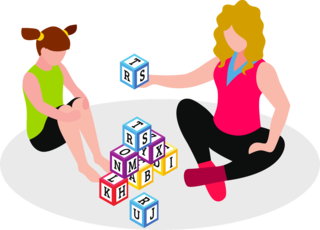Autism
Ideas for Communicating With Your Autistic Child
Ways to strengthen your connection with your ASD child.
Posted October 18, 2022 Reviewed by Tyler Woods
Although their brains work differently, you can communicate with children with ASD (autism spectrum disorder). Think of each communication like molding a brick. At first, the brick is wet and doesn’t support much, but each brick made solidifies and eventually supports the ones which will be placed on top of it. As the bricks set, they begin to form a foundation.
A perfect example is the following communication between my friend Christine and her autistic daughter, Carly. Carly recently returned to middle school, and when Christine asks how her day went at school, she doesn’t always answer.
However, the week following the start of school, Christine applied for a part-time retail job. She hadn’t worked in public for many years, and the anxiety of applying for the position hit her. She thought, “What if some people don’t like me or I don’t like some of them? What if I’m not happy there? What if they expect too much from me?"
When Christine discussed the situation with her sister, her sister said, “Christine, do you think this is how Carly must feel about going to school?” Christine thought for a moment and said, “There’s a good chance she might.” So, Christine decided to share her feelings with her daughter about the new job and what was worrying her. A big smile spread across Carly’s face, “That’s how I feel about school! Now you know how I feel; welcome to my world!”
That’s when Christine realized there was another way to communicate with her autistic daughter. By learning how to build these connections, you prepare your kids for and support them through transitions even when you’re not with them.
Ways to Communicate with Your Autistic Child:
Share Common Feelings
Instead of focusing on how you are different, tune in to how you and your child are similar. They are autistic and do things differently.
Respect Your Child’s Need for Daily Structure
When they know what’s coming, anxiety decreases, making communication easier. Carly was a miserable baby before Christine put her on a strict schedule. Carly happily latched right onto this structure and, as a toddler, would even start climbing up the stairs to her bedroom before she knew it was nap time. Consistent routines may help your child feel safe and that they have a sense of control over the change in their lives.

Presume Competence
When the autism diagnosis comes in, the neurologists often lowball you. They tell you everything your child won’t be able to do. They can communicate with you; it may just look different. Presume that they can and offer patience when it’s needed.
Give Your Child Choices
A lack of control breeds anxiety in autism; even if the choices are yours, try to give them options. Allowing children with ASD to make choices helps develop problem-solving skills, builds self-esteem, teaches the responsibilities of making choices, and helps to reduce conflicts. Opportunities to communicate and make choices help reduce the chance of interfering behavior and gives the child some control over aspects of their life.
Simplify your Language
If your child is nonverbal, try speaking using single words. For example, if the child is playing with blocks, hold the block and say, “block." If your child already speaks using single words, try short phrases, such as, “stack blocks,” or, “build blocks.” As things progress, start adding one or more words to simple phrases. As a general rule of thumb, speak in phrases with one more word than your child is using.

Find Out How They Have Fun and Join Them
Scripting is an activity where an autistic child will take lines or whole scenes from a book or a show and use them to communicate. Christine would join Carly in doing this; it became a game between them, a way to have fun and connect. Christine could start a script when Carly was angry, which would defuse the situation.
The Bottom Line
Communicating with your autistic child can help them through transitions like returning to school or moving from one activity to another. Using communication to strengthen your relationship with your child (remember the bricks) eventually enables you to understand better how they feel. When your child feels understood, their anxiety decreases, making transitions easier.
And even though every person with autism can learn to communicate, it’s not always through spoken language. Nonverbal individuals with autism have much to contribute to society and can have a meaningful and fulfilling life.




